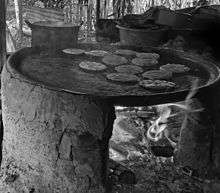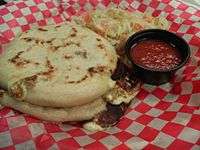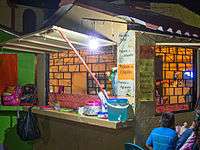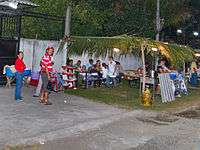Pupusa
|
| |
| Alternative names | Pupusawa |
|---|---|
| Type | Typical dish El Salvador |
| Place of origin | El Salvador |
| Region or state | Olocuilta |
| Main ingredients | Corn masa or rice flour, cheese (usually Quesillo), pork meat, refried beans |
|
Amount per 100 g: | |
|
| |
A pupusa (Spanish pronunciation: [puˈpusa], from Pipil pupusawa) is a traditional Salvadoran dish made of a thick, handmade corn tortilla (made using masa de maíz, a cornmeal dough used in Mesoamerican cuisine). Pupusas are commonly prepared with a variety of fillings:
- Pupusa revuelta contains a blend of cheese, pork (chicharrón), and refried beans
- Pupusa de quesillo or pupusa de queso contains cheese (queso, usually a soft cheese called quesillo found throughout Central America)
- Pupusa de chicharrón contains cooked and seasoned pork meat ground to a paste consistency (called chicharrón, not to be confused with fried pork rind, which is also known as chicharrón in some other countries)
- Refried beans (frijoles refritos)
- Queso con loroco (loroco is a vine flower bud from Central America)
Pupusas are typically served with curtido (lightly fermented cabbage slaw with red chilies and vinegar).
Pupusas are cooked on a comal which is a smooth flat griddle, not fried. Pupusas are similar to the South American arepa, the main differences being that pupusas are filled prior to cooking and pupusas are made from nixtamalized maize whereas arepas are made from untreated corn flour.
The average revuelta pupusa contains around 400 calories.[1]
The Mexican gordita is also similar to the Salvadoran pupusa, but the ingredients vary. Gorditas generally have more filling than pupusas (hence the name gordita—"little fatty") and normally have an opening at the center of the tortilla.
Etymology
Pupusa is the Spanish rendering of popotlax, which is a combination of the Pipil or Nahuatl words popotl meaning large, stuffed, bulky, and tlaxkalli which means tortilla. Or it comes from the Pipil language, pupusawa.[2]
History


Pupusas were first created centuries ago by the Pipil tribes who inhabited the territory now known as El Salvador. Cooking implements for their preparation have been excavated in Joya de Cerén, "El Salvador's Pompeii", site of a native village that was buried by ashes from a volcano explosion, and where foodstuffs were preserved as they were being cooked almost 2000 years ago. The instruments for their preparation have also been found in other archaeological sites in El Salvador.
The pre-Columbian pupusa were vegetarian and half-moon shaped. They were filled with squash flowers and buds, herbs such chipilin and mora, fungi and salt. By 1570 meat had been incorporated into the filling, as noted by Franciscan monk Bernardino De Sahagun.[3]
In the late 1940s, pupusas were still not widespread across El Salvador, and were mostly localized in the central towns, such as Quezaltepeque, and cities of the country. As the population began migrating to other areas in the 1960s, pupusa stands proliferated across the country and in neighboring areas of Honduras and Guatemala, sometimes with variations in shape, size or filling. In Guatemala during the 1970s, pupusas had a half-moon shape. The half-moon shape would be considered a half-eaten pupusa in the Chalatenango area; fish pupusas were uncommon, and pupusas served east of the Lempa River usually had a much larger diameter.
In the 1980s, the Salvadoran civil war forced a Salvadoran migration to other countries, mainly the United States. Therefore, pupusas became available outside the country wherever a Salvadoran community was found. Immigrants have brought the dish to most areas of the United States. Pupuserías also may be found in many areas of Canada. In recent years, pupusas can even be found in some Latin American restaurants in Adelaide,[4] Melbourne and Sydney in Australia.
On 1 April 2005, the Salvadoran Legislative Assembly declared pupusas as the national dish of El Salvador and every second Sunday of November would be National Pupusas Day. A fair is typically held on the day in the capitol and a few big cities. On 10 November 2007, in celebration of National Pupusa day, the Secretary of Culture organized a fair in the capital park in which they would make the world biggest pupusa. The pupusa was 3.15 meters in diameter and was made with 200 lb. of masa, 40 lb. of cheese, and 40 lb. of chicharrón. It fed 5,000 people. Five years later, the record was broken again with a pupusa with 4.25 meters in diameter.[3]
On 25 September 2011 the pupusas were named that year’s Best Street Food in New York.[5]
Both at home and abroad, pupusas are traditionally served with curtido (a pickled cabbage relish, analogous to German Sauerkraut and Korean kimchi that comes in mild and spicy varieties) and tomato sauce, and are traditionally eaten by hand.
Many local folklore tales surround the dish; they often tell of diverse origins or effects of pupusas on people.
Controversy
El Salvador and Honduras have disputed as to where the pupusa originated. While not as popular a dish in Honduras, pupusas can still be found spread throughout the nation. Salvadoran archeologist Roberto Ordonez attributed the creation of the pupusa to the Pipil people due to the name meaning ('swollen') in the Pipil language, and the artifacts found in the Joya de Ceren which show ingredients and tools that were used to make an early version of pupusas. Honduran etymologists say that since the Pipil language is so close to the Nahuatl language, the Honduran Nahua tribe could have created the dish.[6] The topic of the pupusa’s origin also came up during the negotiation for the CAFTA-DR. Both nations wanted to make the pupusa an exclusive export. After 2 days the Honduran delegation ceded the right to El Salvador.[7]
Variants and cousins
A variant of the pupusa in El Salvador is the pupusa de arroz. Rice flour is used to make the dough and they are usually stuffed with chopped pork, cheese, beans, zucchini, and other vegetables. They hail from the town of Olocuilta, located to the east of San Salvador, but are now readily available throughout the country. Another regional variation, found in Alegría, is the pupusa de banano, which calls for the addition of plantain bananas to the pupusa.
Pupusas made in the United States are typically made with Maseca (brand) commercial corn flour-masa mix) instead of fresh masa harina. Some high-end pupuserías in the United States use rice flour and wheat flour versions.
In Santa Fe, New Mexico, variations include using spinach, pepperoni, cheese, and green chile.
A similar Mexican dish is called a gordita (literally, "little fatty"), but gorditas are usually open at one end. In Venezuela, they make arepas (where the dough is cooked first, and then sliced in half and stuffed somewhat like a hamburger). Colombia has its own recipe of arepas, but, unlike Venezuelan, Colombian arepas are usually eaten without filling, or the filling is placed inside the dough before cooking. Pupusas are also found in neighboring Central American countries. Honduran versions often use the local quesillo type of cheese for the filling. In Costa Rica, both "Salvadoran pupusas" and "pupusas" are available, the latter being a local version. There, they are a staple of the food stalls at regional carnivals known as fiestas.
Taco Cabana, a Tex-Mex chain in Texas, created a dish called the pupusa that has no relation to the Salvadoran food.[8]
 Pupusas revueltas stuffed with meat, beans and cheese
Pupusas revueltas stuffed with meat, beans and cheese Pupusas and tomato sauce
Pupusas and tomato sauce Pupusas for carryout, in El Salvador, are wrapped in plastic and then in paper. (Here the paper is unwrapped to show the pupusas)
Pupusas for carryout, in El Salvador, are wrapped in plastic and then in paper. (Here the paper is unwrapped to show the pupusas) A pupusería in Santiago Texacuangos, El Salvador. Note the various pupusas advertised on the wall: Chicken, Jalapeño, chipilín, and avocado
A pupusería in Santiago Texacuangos, El Salvador. Note the various pupusas advertised on the wall: Chicken, Jalapeño, chipilín, and avocado A pupusería in Olocuilta.
A pupusería in Olocuilta. An outdoor pupusería in El Salvador at night
An outdoor pupusería in El Salvador at night
Economy
In spite of their low market price, pupusas represent an important element in the economy of El Salvador. In addition to whole pupusas, the individual ingredients are also exported; in 2005 for example, US$604,408 worth of loroco was sold to the United States alone. Frozen pupusas can be found in the refrigerated section of many Hispanic and international supermarkets in the United States, especially ones that are located in highly concentrated areas of Salvadorans such as Washington, D.C. & Long Island, New York.
Pupusa sales play a big role in the Salvadoran economy. According to the Salvadoran Ministry of Economy between the years of 2001–2003, pupuserias generated 22 million dollars. The export of ingredients such as loroco has also helped boost the economy.[9] As of 2005, 300,000 people made pupusas for a living, with a majority of them being women.
See also
References
- ↑ "La Prensa Grafica". Retrieved 9 May 2015.
- ↑ History of Pupusas | Multi Cultural Cooking Network. Multiculturalcookingnetwork.wordpress.com (3 December 2009). Retrieved on 2016-12-02.
- 1 2 "Historia de la Pupusa Salvadorena". redislam.net. January 2013.
- ↑ "Coffee Amigo". facebook.com.
- ↑ Resnick, Perry (26 September 2011). "The best street food in New York". The Guardian.
- ↑ "La Guerra de las Pupusas". losangeles.univision.com. 27 July 2011.
- ↑ Gómez, Iván (8 December 2003). "Honduras Insists pupusas".
- ↑ Peralta, Eyder (27 July 2006). "Bona fide pupusas: Classic or clueless? Here's how to tell", Houston Chronicle Dining Guide, p. 4
- ↑ "Las Pupusas: ícono culinario salvadoreño celebrará su día". El Periodista. 4 November 2014.
Further reading
| Wikimedia Commons has media related to Pupusa. |
- Planet, L.; Staff, Lonely Planet Publications (2012). The World's Best Street Food: Where to Find It and How to Make It. Lonely Planet Publications. p. 137. ISBN 978-1-74321-664-4. Retrieved 30 July 2016.